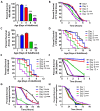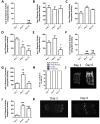Aging causes decreased resistance to multiple stresses and a failure to activate specific stress response pathways
- PMID: 27053445
- PMCID: PMC4925828
- DOI: 10.18632/aging.100939
Aging causes decreased resistance to multiple stresses and a failure to activate specific stress response pathways
Abstract
In this work, we examine the relationship between stress resistance and aging. We find that resistance to multiple types of stress peaks during early adulthood and then declines with age. To dissect the underlying mechanisms, we use C. elegans transcriptional reporter strains that measure the activation of different stress responses including: the heat shock response, mitochondrial unfolded protein response, endoplasmic reticulum unfolded protein response, hypoxia response, SKN-1-mediated oxidative stress response, and the DAF-16-mediated stress response. We find that the decline in stress resistance with age is at least partially due to a decreased ability to activate protective mechanisms in response to stress. In contrast, we find that any baseline increase in stress caused by the advancing age is too mild to detectably upregulate any of the stress response pathways. Further exploration of how worms respond to stress with increasing age revealed that the ability to mount a hormetic response to heat stress is also lost with increasing age. Overall, this work demonstrates that resistance to all types of stress declines with age. Based on our data, we speculate that the decrease in stress resistance with advancing age results from a genetically-programmed inactivation of stress response pathways, not accumulation of damage.
Keywords: C. elegans; aging; heat shock response; hormesis; induced thermotolerance; stress resistance.
Conflict of interest statement
The authors declare no conflict of interest.
Figures








Similar articles
-
The mitochondrial unfolded protein response, a conserved stress response pathway with implications in health and disease.J Exp Biol. 2014 Jan 1;217(Pt 1):137-43. doi: 10.1242/jeb.090738. J Exp Biol. 2014. PMID: 24353213 Free PMC article. Review.
-
Age-dependent heat shock hormesis to HSF-1 deficiency suggests a compensatory mechanism mediated by the unfolded protein response and innate immunity in young Caenorhabditis elegans.Aging Cell. 2024 Oct;23(10):e14246. doi: 10.1111/acel.14246. Epub 2024 Jun 19. Aging Cell. 2024. PMID: 38895933 Free PMC article.
-
Mechanisms of amino acid-mediated lifespan extension in Caenorhabditis elegans.BMC Genet. 2015 Feb 3;16(1):8. doi: 10.1186/s12863-015-0167-2. BMC Genet. 2015. PMID: 25643626 Free PMC article.
-
Transcellular chaperone signaling: an organismal strategy for integrated cell stress responses.J Exp Biol. 2014 Jan 1;217(Pt 1):129-36. doi: 10.1242/jeb.091249. J Exp Biol. 2014. PMID: 24353212 Free PMC article. Review.
-
Hormetic heat shock and HSF-1 overexpression improve C. elegans survival and proteostasis by inducing autophagy.Autophagy. 2017 Jun 3;13(6):1076-1077. doi: 10.1080/15548627.2017.1299313. Epub 2017 Mar 23. Autophagy. 2017. PMID: 28333578 Free PMC article.
Cited by
-
HSF-1: Guardian of the Proteome Through Integration of Longevity Signals to the Proteostatic Network.Front Aging. 2022 Jul 8;3:861686. doi: 10.3389/fragi.2022.861686. eCollection 2022. Front Aging. 2022. PMID: 35874276 Free PMC article. Review.
-
Activation of DAF-16/FOXO by reactive oxygen species contributes to longevity in long-lived mitochondrial mutants in Caenorhabditis elegans.PLoS Genet. 2018 Mar 9;14(3):e1007268. doi: 10.1371/journal.pgen.1007268. eCollection 2018 Mar. PLoS Genet. 2018. PMID: 29522556 Free PMC article.
-
CCR4-NOT complex in stress resistance and longevity in C. elegans.Aging (Albany NY). 2024 May 16;16(10):8400-8401. doi: 10.18632/aging.205918. Epub 2024 May 16. Aging (Albany NY). 2024. PMID: 38761173 Free PMC article. No abstract available.
-
Maral Root Extract and Its Main Constituent 20-Hydroxyecdysone Enhance Stress Resilience in Caenorhabditis elegans.Int J Mol Sci. 2025 Apr 15;26(8):3739. doi: 10.3390/ijms26083739. Int J Mol Sci. 2025. PMID: 40332350 Free PMC article.
-
Mild mitochondrial impairment enhances innate immunity and longevity through ATFS-1 and p38 signaling.EMBO Rep. 2021 Dec 6;22(12):e52964. doi: 10.15252/embr.202152964. Epub 2021 Oct 7. EMBO Rep. 2021. PMID: 34617666 Free PMC article.
References
-
- Cotto JJ, Morimoto RI. Stress-induced activation of the heat-shock response: cell and molecular biology of heat-shock factors. Biochemical Society symposium. 1999;64:105–118. - PubMed
-
- Haynes CM, Ron D. The mitochondrial UPR - protecting organelle protein homeostasis. Journal of cell science. 2010;123:3849–3855. - PubMed
Publication types
MeSH terms
LinkOut - more resources
Full Text Sources
Other Literature Sources
Medical
Molecular Biology Databases
Miscellaneous

